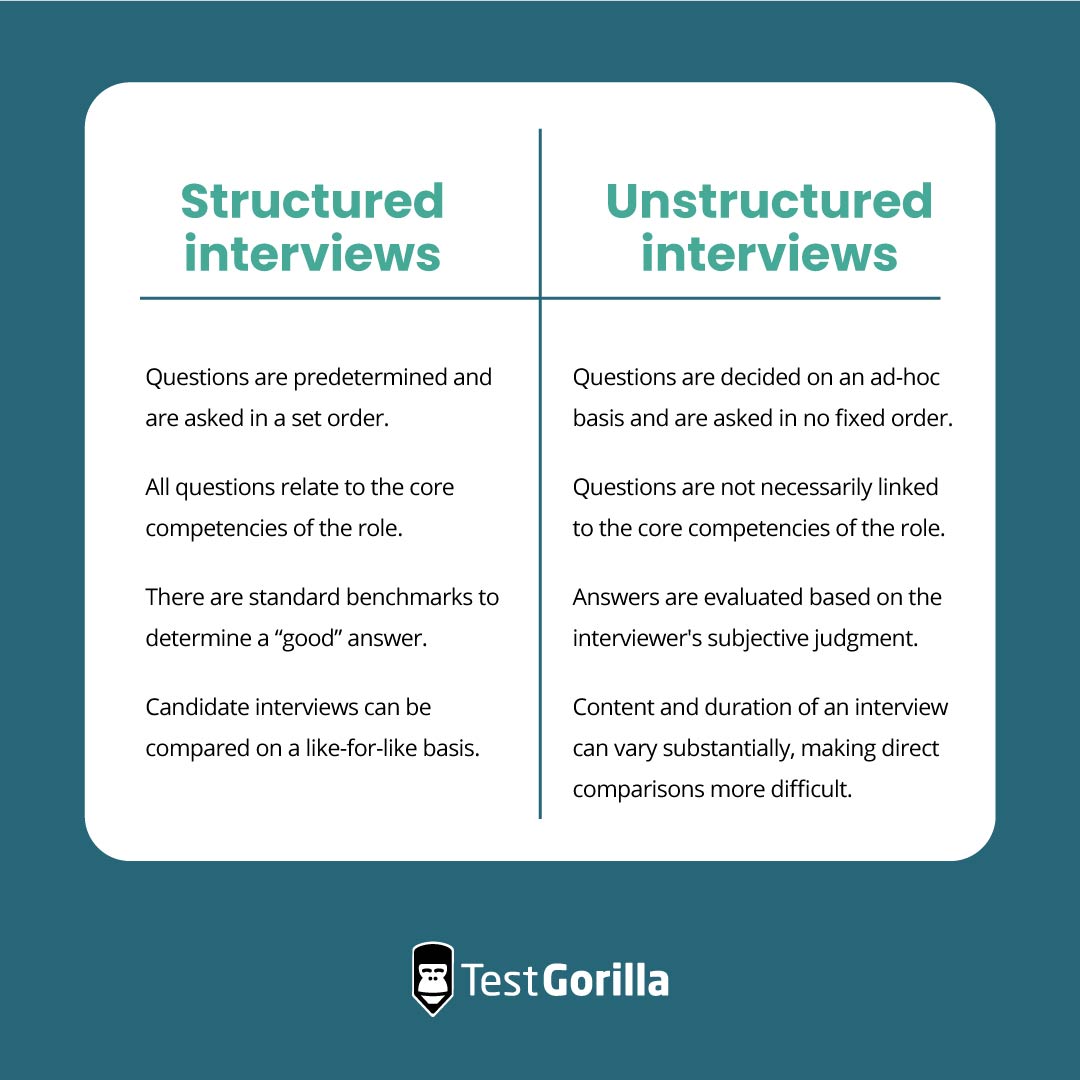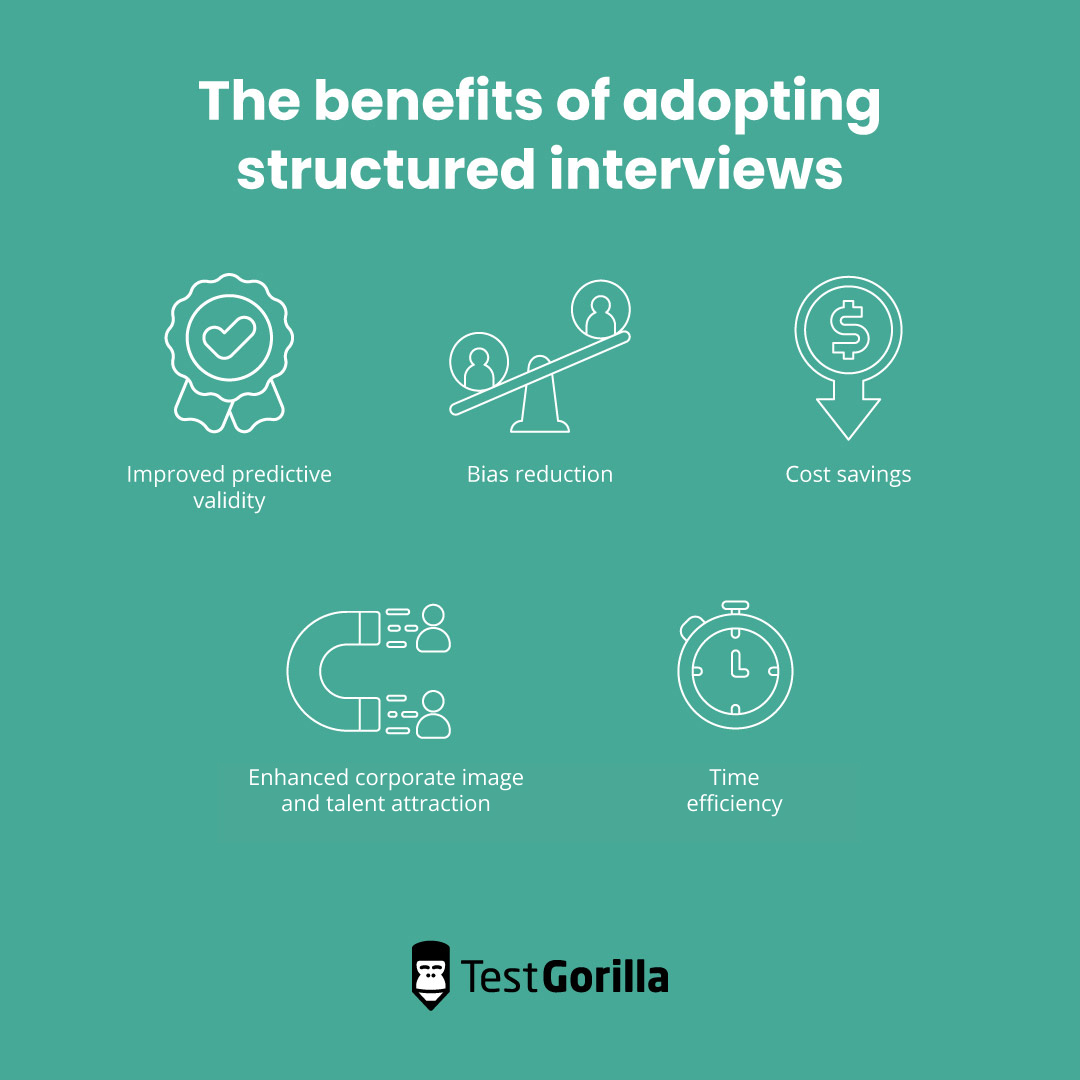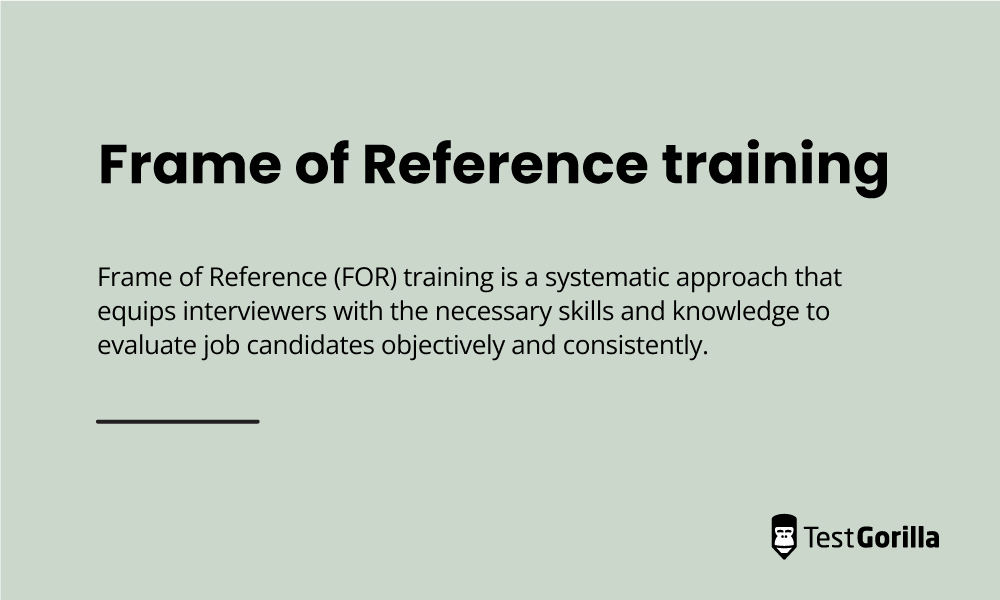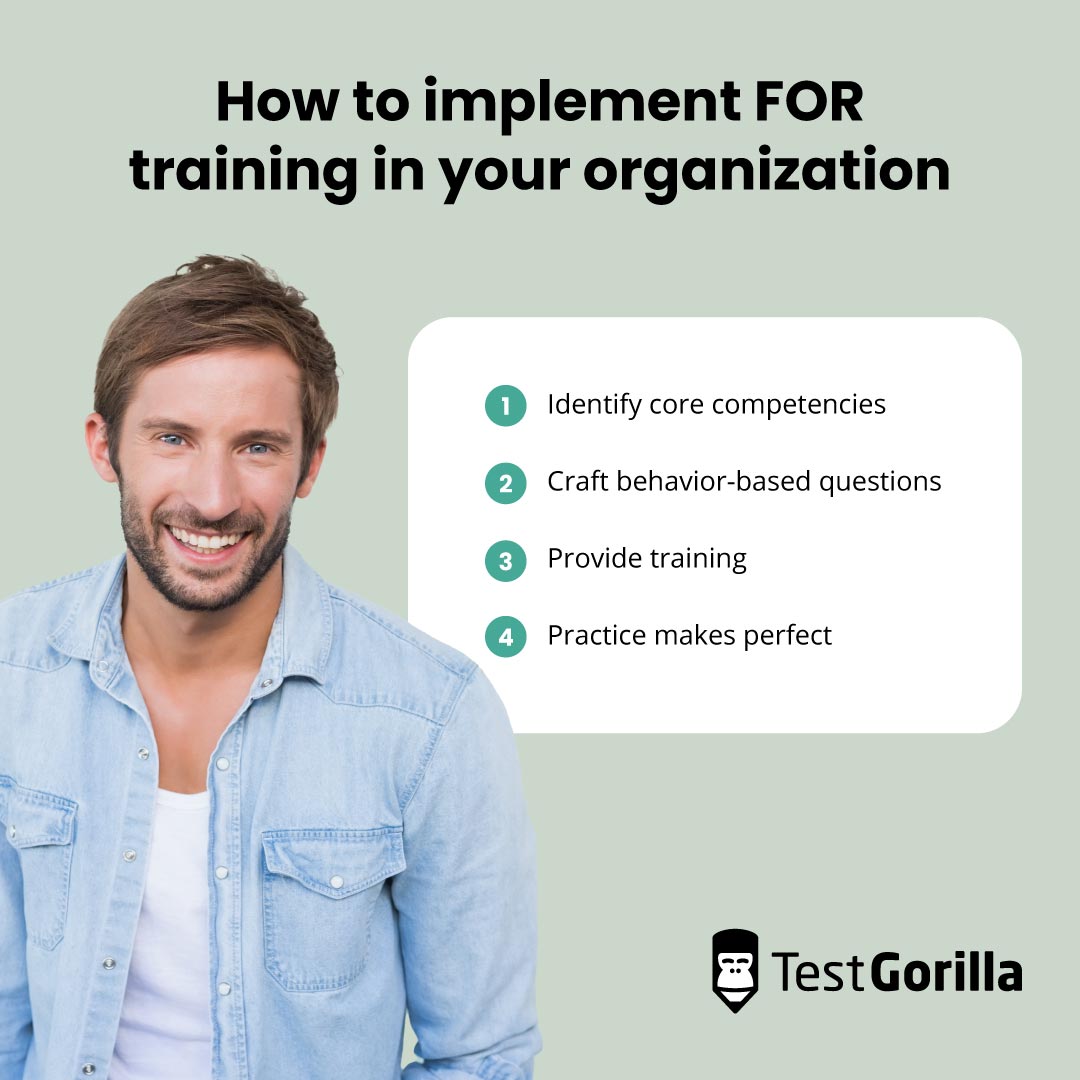Mastering the art of structured interviews: The science behind frame of reference training
Science series materials are brought to you by TestGorilla’s team of assessment experts: A group of IO psychology, data science, psychometricians, and IP development specialists with a deep understanding of the science behind skills-based hiring.
In the fast-paced world of talent acquisition, staying ahead of the curve is essential for hiring managers and recruiters alike. To identify the right candidates and make informed decisions, understanding the science of structured interviews and Frame of Reference (FOR) training is important. In this blog post, we delve into the essentials of structured interviews and how FOR training can elevate your hiring process.
Table of contents
Structured interviews unveiled
Structured interviews, often regarded as the gold standard of hiring, are a well-established method for evaluating job candidates. But what sets them apart from other interview types, such as unstructured interviews
Structured interviews are characterized by a predetermined set of questions asked to all candidates, ensuring a consistent and fair assessment process. Each question is carefully crafted to elicit specific information about a candidate's role-relevant skills, competencies, and qualifications, directly related to the job requirements.
In contrast, unstructured interviews are more free-form, with interviewers asking ad-hoc questions based on their intuition or personal preferences. This approach introduces subjectivity and bias, making it less reliable for evaluating candidates objectively.
Structured Interviews: The Numbers Speak
Structured interviews are not just a trendy hiring method; they offer a data-driven approach that yields concrete results. According to a comprehensive study by the International Journal of Selection and Assessment, structured interviews consistently outperform unstructured ones, delivering impressive figures to support their adoption.
5 benefits of adopting structured interviews
Improved Predictive Validity: Structured interviews have been shown to increase the predictive validity of hiring decisions by up to 40% compared to unstructured interviews. This means that when you use structured interviews, you're 40% more likely to select candidates who are the right fit for the job.
Bias Reduction: By using a standardized set of questions, structured interviews reduce the impact of unconscious bias. In an article published in the Journal of Graduate Medical Education, researchers found that interviewers using standardized behavioral questions and a clear scoring system reduced racial bias during the candidate evaluation process. This results in fairer evaluations, with a potential reduction in hiring-related legal challenges.
Cost Savings: A study conducted at Google showed that implementing structured interviews with pre-made, high-quality questions, guides, and rubrics resulted in significant time savings, cutting approximately 40 minutes per interview. This not only streamlines the hiring process but also translates into cost savings, as less time spent on interviews means reduced labor costs associated with recruitment.
Enhanced Corporate Image and Talent Attraction: Google's research also revealed that rejected candidates who participated in a structured interview were 35% happier than those who did not. This finding underscores the importance of structured interviews in shaping a positive candidate experience, contributing to a stronger corporate image and reputation. A favorable corporate image can attract top talent and improve the company's standing among prospective candidates, ultimately helping in securing the best talent in a competitive job market.
Time Efficiency: Standardized interviews streamline the selection process, enabling you to evaluate candidates more efficiently. This can save valuable time, especially in industries with high turnover rates.
The best insights on HR and recruitment, delivered to your inbox.
Biweekly updates. No spam. Unsubscribe any time.
Frame of Reference (FOR) training: A key ingredient
So, what exactly is Frame of Reference training, and why is it indispensable for interviewers?
Frame of Reference (FOR) training, in the context of structured interviews and hiring, is a systematic approach that equips interviewers with the necessary skills and knowledge to evaluate job candidates objectively and consistently. It involves defining clear criteria for assessing candidate responses based on the specific competencies and behaviors required for the job.
FOR training aims to establish a shared understanding among interviewers about what constitutes an ideal response, ensuring that all interviewers evaluate candidates using the same criteria. This training helps reduce subjectivity and bias in the interview process, improving and stabilizing rating accuracy compared to control groups and ultimately leading to fairer and more accurate hiring decisions.
Frame of Reference training: The game changer
Now, let's quantify the impact of FOR training on your hiring process. FOR training, when integrated effectively, can further enhance the benefits of structured interviews:
Enhanced Consistency: FOR-trained interviewers consistently rate candidate responses, reducing variability in evaluations. This results in a 25% increase in inter-rater reliability, ensuring everyone is on the same page when assessing candidates.
Better Hiring Decisions: A 2019 study published in the Journal of Organizational Behavior showed that some forms of FOR training resulted in significantly improved criterion validity, defined as the correlation between the interviewer’s rating and actual on-the-job performance. This means a higher likelihood of selecting candidates who not only meet the job requirements but also become high performers within the organization.
How to implement FOR training in your organization:
Identify Core Competencies: Begin by identifying the core competencies essential for success in the role. These might include technical skills, interpersonal abilities, problem-solving, or leadership qualities.
Craft Behavior-Based Questions: Develop a set of behavior-based interview questions that directly relate to the identified competencies. These questions should prompt candidates to provide specific examples from their past experiences.
Provide Training: Train your interviewers on the selected competencies and the scoring criteria for each response. Ensure they understand what to look for in interviewees’ answers so they can accurately assess each candidate’s fit for the role.
Practice Makes Perfect: Conduct mock interviews and provide feedback to your interviewers to refine their skills in evaluating candidate responses.
Follow structured interview best practices and elevate your hiring decisions
Mastering the art of structured interviews and implementing Frame of Reference training are key to making informed, objective hiring decisions. These scientifically backed methodologies not only enhance consistency and reduce bias in your recruitment process but also lead to improved predictive validity, better quality hires, and reduced turnover rates.
By adopting these strategies, you can transform your interviewing strategy from good to great - all while saving on time and cost.
At TestGorilla, we understand that structured interviews become even more powerful when they're part of a comprehensive hiring process. After using our reliable testing instruments for pre-screening candidates based on their skills and qualifications, it's time to dive deeper with structured interviews guided by FOR training principles. This combination ensures a robust selection procedure grounded in science - helping you identify top-performing candidates who will add value over time.
To find out more about the data and research shaping the cutting-edge of recruitment science, and the science behind TestGorilla, check out some of the other blog posts in our science series:
Revisiting the validity of different hiring tools: New insights into what works best
How to select tests for an assessment (and avoid a skill overlap)
Sources
Rizi, M. S., & Roulin, N. (2023). Does media richness influence job applicants’ experience in asynchronous video interviews? examining social presence, impression management, anxiety, and performance. International Journal of Selection and Assessment. https://doi.org/10.1111/ijsa.12448
Schmidt, F. L., Oh, I.-S., & Shaffer, J. A. (2016). The Validity and Utility of Selection Methods in Personnel Psychology: Practical and Theoretical Implications of 100 Years of Research Findings.
Balhara, K. S., Weygandt, P. L., Ehmann, M. R., & Regan, L. (2021). Navigating bias on interview day: Strategies for charting an inclusive and equitable course. Journal of Graduate Medical Education, 13(4), 466–470. https://doi.org/10.4300/jgme-d-21-00001.1
Gorman, C. Allen & Rentsch, Joan. (2009). Evaluating frame-of-reference rater training effectiveness using performance schema accuracy. Journal of Applied Psychology, 94(5), 1336–1344. https://doi.org/10.1037/a0016476
Tsai, M., Wee, S., & Koh, B. (2019). Restructured frame‐of‐reference training improves rating accuracy. Journal of Organizational Behavior, 40(6), 740–757. https://doi.org/10.1002/job.2368
You've scrolled this far
Why not try TestGorilla for free, and see what happens when you put skills first.


















